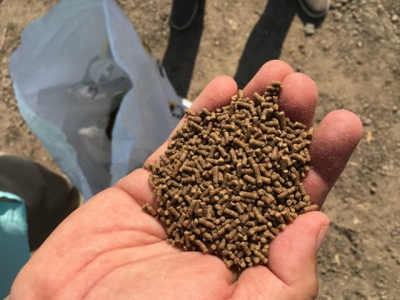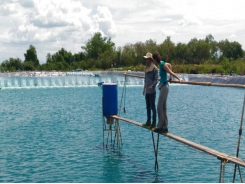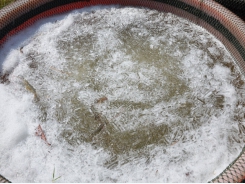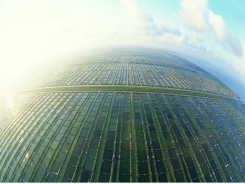Least-cost formulation software in shrimp aquafeed production - Part 1

1/ Maximizing nutritional content, lowering costs, increasing profits
The use of feed formulation software has helped aquafeed formulators design feeds that maximize nutritional content for their species while lowering costs in order to increase profits.
The success of aquafarmers depends on several parameters. One of the most important ones is the quality of aquafeeds used for broodstock maturation, larval rearing and farm grow-out to market size. In the latter, cost of aquafeeds can account for more than 50 percent of the production cost, so it is critical that quality feeds are used. The quality of shrimp grow-out feeds depends on several factors, including the use of good ingredients, and proper formulation, manufacturing and management. Here I will discuss the use of least-cost feed formulation software.
2/ Nutritional requirements and formulated aquafeeds
The nutritional requirements of penaeid shrimp, their feed formulation and manufacture have been extensively discussed and documented, but there is still much to learn. The essential dietary nutrients for shrimp include amino acids, fatty acids, energy, phospholipids, cholesterol, minerals and vitamins. With industry expansion there has been an intensification of production and an increased dependence on the use of manufactured dry feed, which often represents the highest production cost.
Protein is typically the most expensive macronutrient in shrimp feeds, and dietary protein levels from 18 to 60 percent have been recommended for various species and sizes of marine shrimp species, possibly due to their wide range of natural feeding habits. Postlarval shrimp require a higher dietary protein level than older shrimp. As production intensity increases, so does the importance of a balanced feed. Most extensive shrimp farms work at very low stocking densities and do not apply formulated feed, while semi-intensive farms depend on feeds for at least the last two-thirds to one-half of the production cycle, and intensive farms shrimp depend on commercial diets for most of the production cycle.
Formulated shrimp feeds are complex products and the main components have traditionally been, depending on the species, fishmeal (0 to 30 percent), wheat flour (20 to 35 percent) and soybean meal (15 to 35 percent), These few ingredients contribute most, if not all, of the protein, amino acids and energy, while the remaining is comprised of several other ingredients (including various lipids) and microingredients that contribute the balance of essential fatty acids, vitamins, minerals, attractants, binders, preservatives, pigments and health additives.
Around 110 additives are believed to be the most common ingredients used in shrimp feeds today. Attractants include animal byproducts (crustacean meals, squid byproducts, low molecular weight fish and meat extracts) and purified compounds (free amino acids, artificial flavors, betaine and nucleotides). Enzymes supplements improve digestibility of phytate, fiber, indigestible sugars, and other components. Various additives, including coccidiostats, antibiotics and hormones have been used as growth promoters in shrimp.
Other additives, including immunostimulants, probiotics and vaccines, are being used to stimulate the shrimp’s immune system of shrimp and improve disease resistance to disease. This has become especially important to reduce outbreaks of shrimp viral diseases. Immunostimulants used include beta glucans, bacterial extracts, blood plasma, seaweed byproducts and yeast. Probiotics – live cultures of beneficial bacteria added to some culture systems and feeds, typically larval diets – are another type of additive. Grains used in shrimp feed can be infected with fungus, which can expose shrimp to mycotoxins. Several products are used to absorb mycotoxins and reduce their toxicity.
The main lipid additives are essential fatty acids, phospholipids, emulsifiers and cholesterol from fish and squid oil. The primary source of supplemental phospholipids for shrimp diets is lecithin. Cholesterol is another essential nutrient for shrimp, and even though it is naturally present in fish oil, fishmeal, shrimp head meal and squid byproducts, it often has to be added to reach needed levels.
Shrimp diets are often supplemented with phosphorus and a complete trace mineral and vitamin premix. Vitamin C is rapidly lost during storage and exposure to heat and moisture, and a stable form is typically used, such the polyphosphate, monophosphate-Ca, monophosphate-Mg, or encapsulated ascorbic acid.
3/ Understanding aquafeed formulation
Formulation involves the determination of the amount of each ingredient to include in a particular formula, to provide all required nutrient levels for the target species and stage of development. Formulation is a dynamic process, as changes in ingredients or prices will necessitate a change in the formula to ensure that the profile of nutrients in the designed formula is maintained. A common misunderstanding is that once a formula is developed, it will not need to be modified. Not true, unless the ingredients’ nutrient profiles do not change, and this is seldom the case, because ingredients can vary within an adequate range and every time there is a deviation outside the acceptable range a new formula must be produced.
In the recent past, animal feed manufacturers used to balance their feeds using hand calculations, and very often relied upon using tedious trial and error methods. For over three decades, many industries have increasingly relied on computer software to solve many problems and the aquaculture industry is no exception to that. In the late 1960s commercial computer software for solving least-cost formulation began to emerge in the market place. These early systems were used on dial-up terminals of mainframes. Although infinitely faster than solutions by hand, they were slow, cumbersome and extremely expensive compared to systems available today.
The development of computer technology and the increased use of linear programming provided the incentive for the first practical least-cost formulation software implementation in the late 1970s, but the breakthroughs only arrived in the 1980s with the advent of personal computers. The development of high-quality formulation programs necessitated a very specialized and unique combination of experience, education, talent, commitment and dedication in various areas, including knowledge of the nutritional requirements of animals; nutritional content of ingredients; availability and cost of feed ingredients; mathematical programming; and computer programming.
4/ Least-cost formulation software to optimize profits
The technique of least-cost feed formulation consists of combining many feed ingredients in a certain proportion as to provide the animal with a balanced nutritional feed at the least possible cost. As such, it requires the professional knowledge of the animal practitioners who can consider special contemplations for the aquaculture industry such as the pellet size, shape and consistency. Other factors specific to the aquaculture industry, such as feed floatability, fast or slow sinking feeds, and life span specific nutrient feeds, must be considered. People involved in formulation must be aware of the variations of nutritional requirements for different species, because aquatic feed formulation needs can be diverse.
Several feed formulation software packages are available on the market. Animal feed formulation is not a new activity, but new and innovative software tools are being developed and introduced into the market every year. These tools enable animal practitioners to maximize nutritional content that may vary at different verse ages and stages in production while controlling costs in order to maximize profitability.
Least-cost feed formulation is an important component within formulation and profit maximization. There are several companies producing computer software for feed formulation. These software packages vary from simple solutions to sophisticated and complex software packages designed for large feed manufacturers that require multi-site, multi-server and multi-blending capabilities. Along with providing feed formulation solutions, these multifaceted software packages can also provide modules for inventory control and production as well as interfaces to accounting systems. And some feed formulation software is specifically designed for a certain species and it may provide tables of nutrient requirements for those specific animals.
Related news
Tools

Phối trộn thức ăn chăn nuôi

Pha dung dịch thủy canh

Định mức cho tôm ăn

Phối trộn phân bón NPK

Xác định tỷ lệ tôm sống

Chuyển đổi đơn vị phân bón

Xác định công suất sục khí

Chuyển đổi đơn vị tôm

Tính diện tích nhà kính

Tính thể tích ao




 From the micro to the macro: probiotics and…
From the micro to the macro: probiotics and…  Evaluating stunning methods in tropical shrimp aquaculture
Evaluating stunning methods in tropical shrimp aquaculture